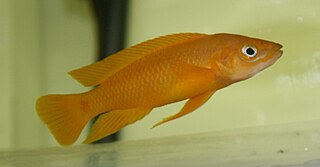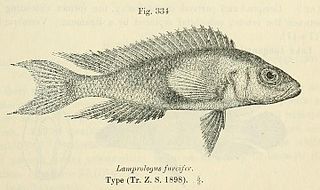
Neolamprologus brevis is a species of cichlid endemic to Lake Tanganyika where it lives in snail shells, primarily of the genus Neothauma. It feeds is on plankton. This species can reach a length of 5.5 centimetres (2.2 in) TL. This species can also be found in the aquarium trade. The males are much larger than the females and can be identified even at a young age.

Neolamprologus leleupi is a species of cichlid endemic to Lake Tanganyika where it occurs throughout the lake. It is a recess-dweller, inhabiting cracks and crevices. It feeds on invertebrates living in the rich biocover of the substrate. This species reaches a length of 10 centimetres (3.9 in) TL. The color of this fish ranges from bright yellow to deep brown. Both color variations exist at each location where this species is found. This relatively small cichlid is a substrate spawner. It is easily confused with the very similar N. longior a fish also endemic to Lake Tanganyika. The specific name honours the Belgian entomologist Narcisse Leleup (1912-2001), who collected the type.
Neolamprologus crassus is a species of cichlid endemic to Lake Tanganyika where it can be found in the southwestern part of the lake, in the waters of the Democratic Republic of the Congo. This species can reach a length of 7 centimetres (2.8 in) TL. It can also be found in the aquarium trade. Some authorities regard this taxon as a synonym of Neolamprologus pulcher.
Neolamprologus falcicula is a species of cichlid endemic to Lake Tanganyika where it is only known from the waters off Burundi. This species can reach a length of 8.1 centimetres (3.2 in) TL. It can also be found in the aquarium trade.

Neolamprologus fasciatus is a species of cichlid endemic to Lake Tanganyika. This species spawns in empty snail shells. This species can reach a length of 15 centimetres (5.9 in) TL. This species can also be found in the aquarium trade. They are piscivores and their prey includes the cichlid fish Variabilichromis moorii.

Neolamprologus furcifer is a species of cichlid endemic to Lake Tanganyika where it prefers to live solitatirily in lightless cracks, crevices, caves, etc. where it feed on other organisms that also dwell in that habitat. This species can reach a length of 15 centimetres (5.9 in) TL. This species can also be found in the aquarium trade, where it is a highly sought-after species.

Neolamprologus gracilis is a species of cichlid endemic to Lake Tanganyika where it is known from Cape Kapampa on the western coast and on the eastern coast from the area of coast below the Mahale Mountains. This species can reach a length of 9 centimetres (3.5 in) TL.

Neolamprologus longior is a species of cichlid endemic to Lake Tanganyika and found at Kabogo Point and Kibwe Bay. This species can reach a length of 9 centimetres (3.5 in) TL. It can also be found in the aquarium trade.

Neolamprologus mondabu is a species of cichlid endemic to Lake Tanganyika except for the southern portion where it is replaced by N. modestus. It prefers areas with rocky substrates, moving to areas with sandy substrates to breed. It feeds on the eggs of Lamprichthys tanganicanus. This species can reach a length of 10.7 centimetres (4.2 in) TL. This species can also be found in the aquarium trade.
Neolamprologus mustax is a species of cichlid endemic to Lake Tanganyika. This species reaches a length of 9 centimetres (3.5 in) TL. It can also be found in the aquarium trade. Individuals are yellow in color and thus resemble juveniles of another cichlid species, Variabilichromis moorii, which may provide N. mustax with greater access to V. moorii feeding territories.
Neolamprologus niger is a species of cichlid endemic to Lake Tanganyika where it is only found along the northern shores. It is a crevice-dweller and feeds on molluscs. This species reaches a length of 9 centimetres (3.5 in) TL. It can also be found in the aquarium trade.
Neolamprologus obscurus is a species of cichlid endemic to Lake Tanganyika where it is only known from southern end of the lake where it inhabits crevices. This species reaches a length of 8.2 centimetres (3.2 in) TL. It can also be found in the aquarium trade.

Neolamprologus olivaceous is a species of cichlid endemic to Lake Tanganyika where it is only known from Ruhanga Bay in the Democratic Republic of the Congo. This species can reach a length of 9 centimetres (3.5 in) TL.
Neolamprologus petricola is a species of cichlid endemic to Lake Tanganyika where it is only known from the shores of the Democratic Republic of the Congo. This species reaches a length of 14 centimetres (5.5 in) TL. It can also be found in the aquarium trade.
Neolamprologus pleuromaculatus is a species of cichlid endemic to Lake Tanganyika where it is only known to occur in the northern half of the lake. This species can reach a length of 12 centimetres (4.7 in) TL. It can also be found in the aquarium trade.

Neolamprologus sexfasciatus is a species of cichlid fish that is endemic to the southern half of Lake Tanganyika in East Africa. It can reach a length of 15 centimetres (5.9 in) TL. This species can also be found in the aquarium trade. It mainly eats snails, and its pharyngeal bones and teeth are adapted to this hard-shelled prey.
Neolamprologus splendens is a species of cichlid endemic to Lake Tanganyika where it is only known to occur around Cape Zongwe in the Democratic Republic of the Congo. This species can reach a length of 8 centimetres (3.1 in) TL.

The fourspine cichlid is a species of cichlid endemic to Lake Tanganyika where it lives in areas with sandy substrates. In addition to feeding on other fishes and insect larvae, this species is specialized to suck molluscs from their shells. This species can reach a length of 20 centimetres (7.9 in) TL. This species can also be found in the aquarium trade.

Neolamprologus tretocephalus is a species of cichlid endemic to Lake Tanganyika where it is found in sandy areas in the northern half of the lake. It is a predator on molluscs. This species can reach a length of 15 centimetres (5.9 in) TL. This species can also be found in the aquarium trade.
Neolamprologus toae is a species of cichlid endemic to Lake Tanganyika. This species reaches a length of 12 centimetres (4.7 in) TL. It can also be found in the aquarium trade.












